Watch a Black Hole eat dinner:
S5 0716+71, a bright blazar currently in a feeding frenzy, invites you over for dinner the next clear night.
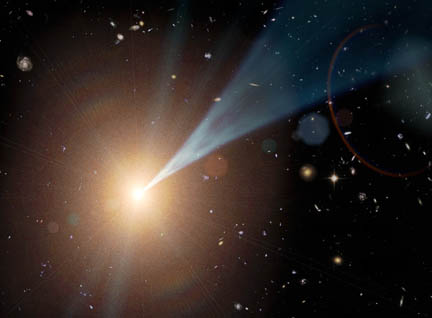
This artist's concept shows a "feeding," or active, supermassive black hole, accretion disk, and a jet streaming outward at nearly the speed of light. Not all black holes have jets, but when they do, the jets can be pointed in any direction. If a jet happens to shine at Earth, the object is called a blazar. When seen from the side, it's a quasar.
NASA / JPL-Caltech
NASA / JPL-Caltech
Don't ask me to pick up the tab for S5 0716+71 — no way can I afford its voracious appetite. With no warning, this otherwise fastidious and faint stellar pinpoint in the circumpolar constellation Camelopardalis rose from magnitude +13.7 to +12.5 within a week. A sure sign it's feeding again.
The cause of this sudden surge in brightness is a supermassive black hole feasting on matter from its host galaxy, an invisible bit of fluff located 3.75 billion light-years from home in Camelopardalis.
S5 0716+71 belongs to a class of violently-variable, active galactic nuclei (AGN) called blazars. Like quasars, blazars begin with a supermassive black hole at the center of a distant galaxy feeding on interstellar dust, rogue planets, and the occasional stray star. As the doomed object falls into the gravitational trap, it's shredded, compressed, and heated to millions of degrees to join its cohorts in a swirling vortex or accretion disk centered on the black hole.
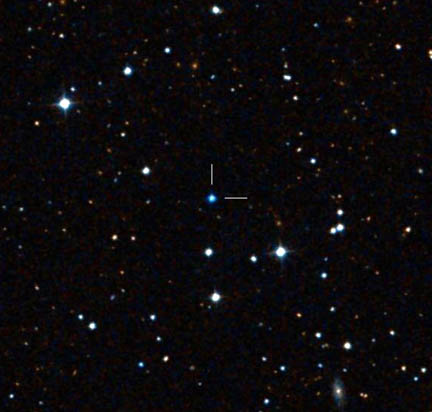
S5 0716+71 is the blue star-like object at center of this 14′ x 14′ wide photo chart. Its current bright outburst started at the end of October. Its host galaxy, 5.4 arcseconds in diameter, is too faint to see even in large telescopes.
DSS2 / Stefan Karge
DSS2 / Stefan Karge
Much of the material within the disk ultimately spirals down the hole, but some of it gets whipped up by powerful magnetic fields generated within the rapidly spinning disk into a pair of relativistic jets. Any matter caught within a jet gets blasted hundreds of thousands of light years into space at 95 to 99% the speed of light.
We now understand blazars and quasars as two sides of the same coin: In a quasar, we view the AGN from the side; in a blazar we stare directly or nearly so into the jet. Observing a blazar is akin to someone shining a flashlight right in your face.
Because we see the jet almost square on, blobs of material within it can exhibit superluminal motion. As they travel toward us at nearly the speed of light, they keep pace with the light they emit. From our perspective, the difference in time of arrival between the two happens over a much shorter time frame, creating the illusion of faster-than-light travel. In October 2011, a team of astronomers observed a superluminal knot of material in S5 0716+71 traveling at an apparent speed ~21 times light speed!
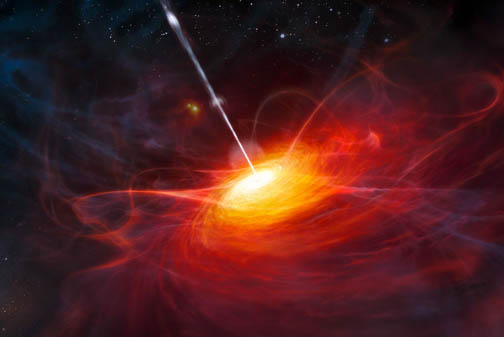
Model of a quasar with accretion disk and relativistic jet. A blazar like S5 0716+71 looks much the same, but we see it face-on instead of from the side.
ESO / M Kornmesser
ESO / M Kornmesser
In addition to their superluminal "powers," blazars exhibit time dilation effects, rapid variations in brightness, and even enhanced brightness due to relativistic effects. All this happens whenever S5 0716+71 encounters fresh material for gnoshing.
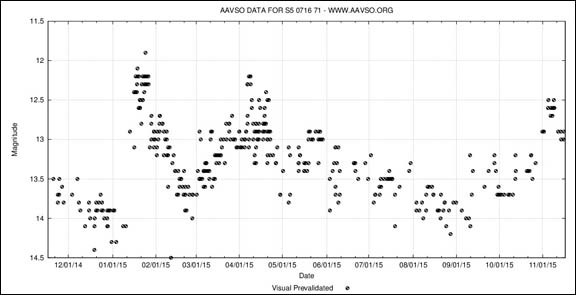
Light curve of the blazar S5 0716+71 based on observations from members of the American Association of Variable Star Observers showing two previous outbursts this year (mid-January and early April) and the start of the current one.
AAVSO
AAVSO
According to AAVSO data, the blazar reached magnitude +12.0, its brightest-ever showing in visible light, in January this year. A second outburst to magnitude +12.2 followed in early April; this November we're in the midst of yet another dinner-for-one production. Normally, the blazar glimmers weakly between 13th and 14th magnitudes.
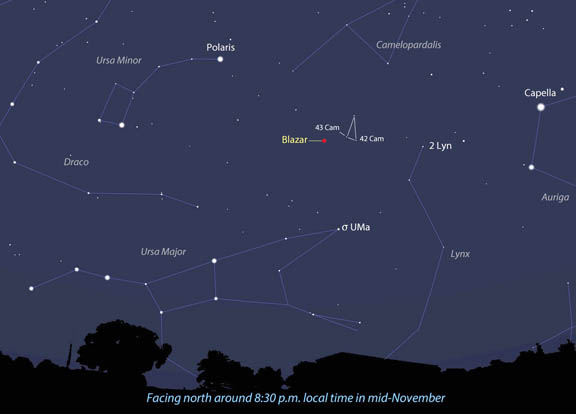
S5 0716+71 is located in the sprawling constellation Camelopardalis between the Big and Little Dippers. To home in on the blazar, start by finding a small triangle of stars roughly halfway between Sigma UMa and Polaris containing the two 5th-magnitude stars 42 and 43 Cam. Then use the more detailed maps below.
Stellarium
Stellarium
An 8-inch telescope currently shows it with ease; even a 6-inch might coax it out under dark, moonless skies with averted vision and a little patience. S5 1716+71 is located in a region devoid of bright stars, but on the up side, it's circumpolar and visible almost any time of night from much of the United States, Canada, and Europe. I usually set the scope up around 8:30 p.m. local time, when it's climbed about the mass of conifers that line my driveway.
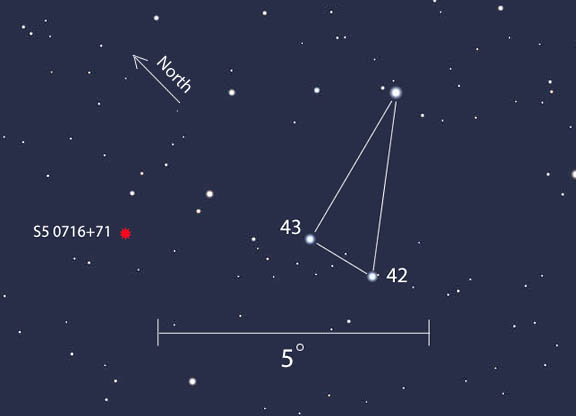
Closer-in map showing the blazar's location northeast of the "little triangle" in Camelopardalis. The blazar's celestial address is R.A. 7h 21′ 53″, Dec. +71° 20′ 36″ (2000).
Stellarium
Stellarium
This past weekend (Nov. 13-15), the blazar held steady at magnitude +12.7-12.8, but I see it's now beginning to fade (Nov. 18). Will that trend continue or will it reverse course and flare brighter yet? That's half the fun. Regular monitoring of S5 0716+71 brings its own rewards and a chance to be one of the first to catch it during the next outburst.
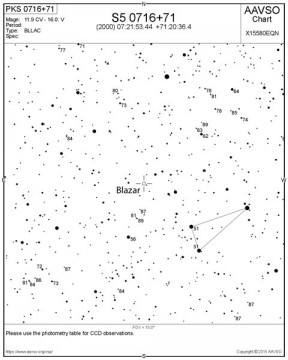
Wide-field AAVSO "A" chart showing the blazar and nearby comparison stars labeled with magnitudes (decimal point omitted). I've drawn in the triangle we used in the previous maps. Click to download a large version to use at the telescope.
AAVSO
AAVSO
To reference its ups and downs, I encourage you to download the free charts of the blazar available from the AAVSO. The pinpoint-accuracy maps also include nearby field stars and their magnitudes which you can use to estimate the object's brightness. If you find yourself in the habit of making brightness estimates, consider joining the association and sharing your observations with amateur and professional astronomers worldwide.
To make a chart, type S5 0716+71 in the Pick a Star box then click Create a Finder Chart. You can either accept the chart shown or click Plot Another Chart. Many options are available.
I confess a love for theoretical astrophysics, a science which uses theoretical models and computer simulations to understand phenomena as diverse as the flow of gas around a black hole to the beginning of time in the Big Bang.
I'm no astrophysicist. Not by a long shot. But thanks to those who are, we can picture and understand the mind-boggling scene that goes by S5 0716+71 when it snaps into focus in our telescopes.
- See more at: http://www.skyandtelescope.com/observing/watch-a-black-hole-eat-dinner111820151811/?utm_source=newsletter&utm_campaign=sky-mya-nl-151120&utm_content=800740_SKY_HP_eNL_151120&utm_medium=email#sthash.s2TOyAa9.dpuf
No comments:
Post a Comment